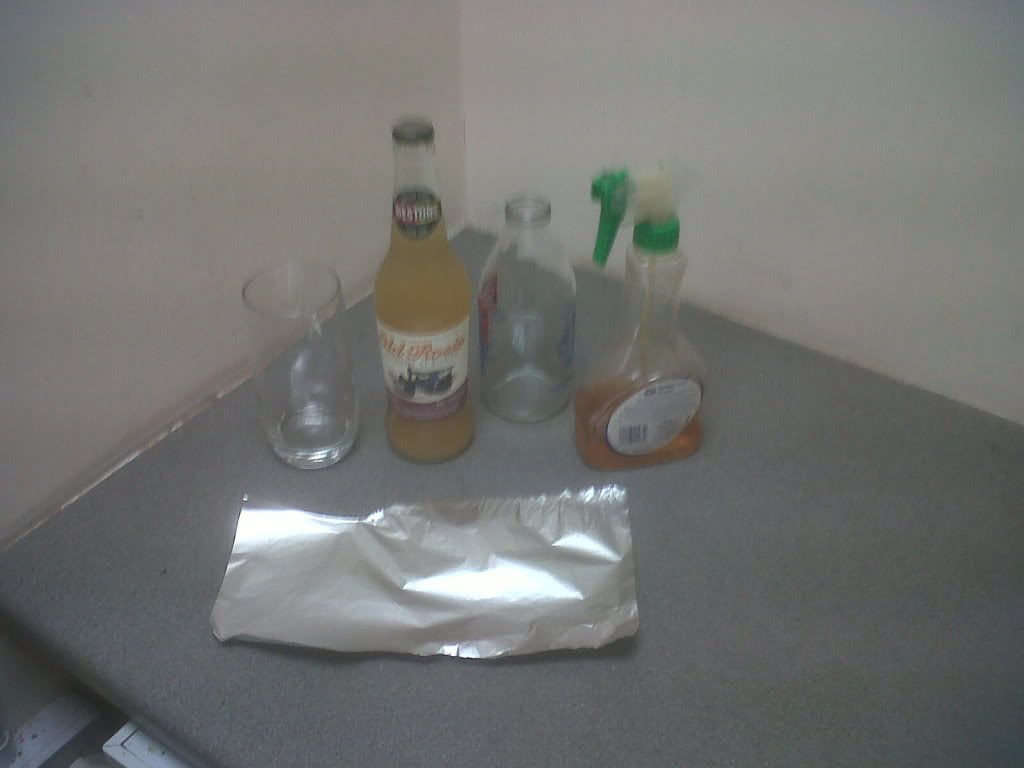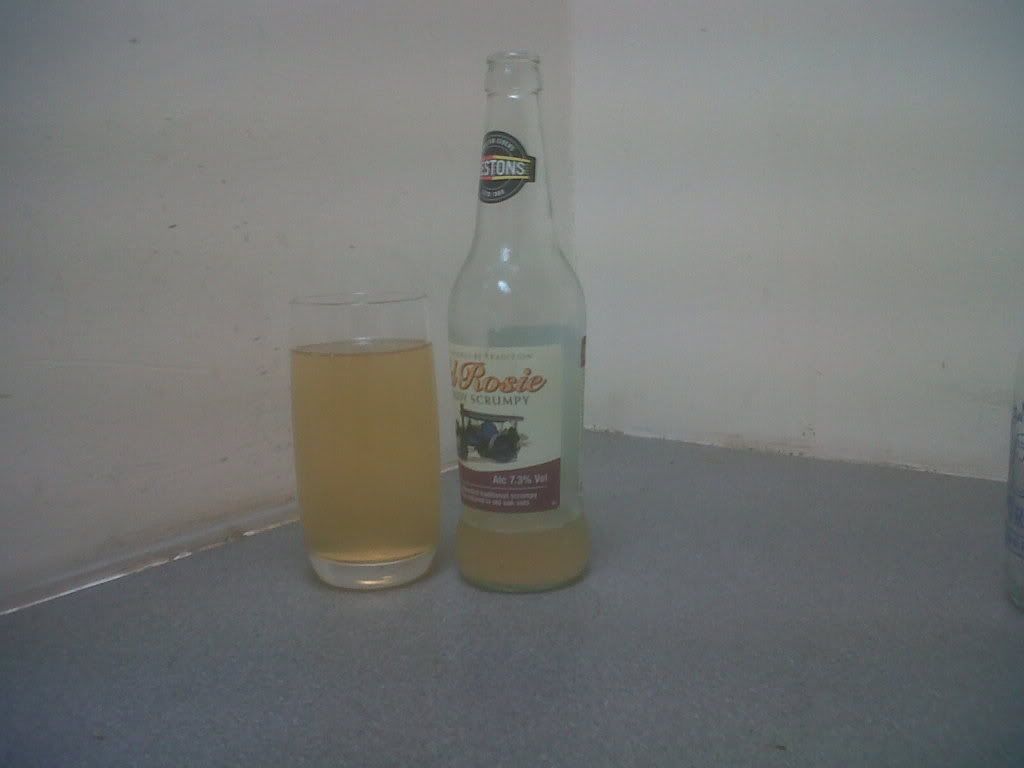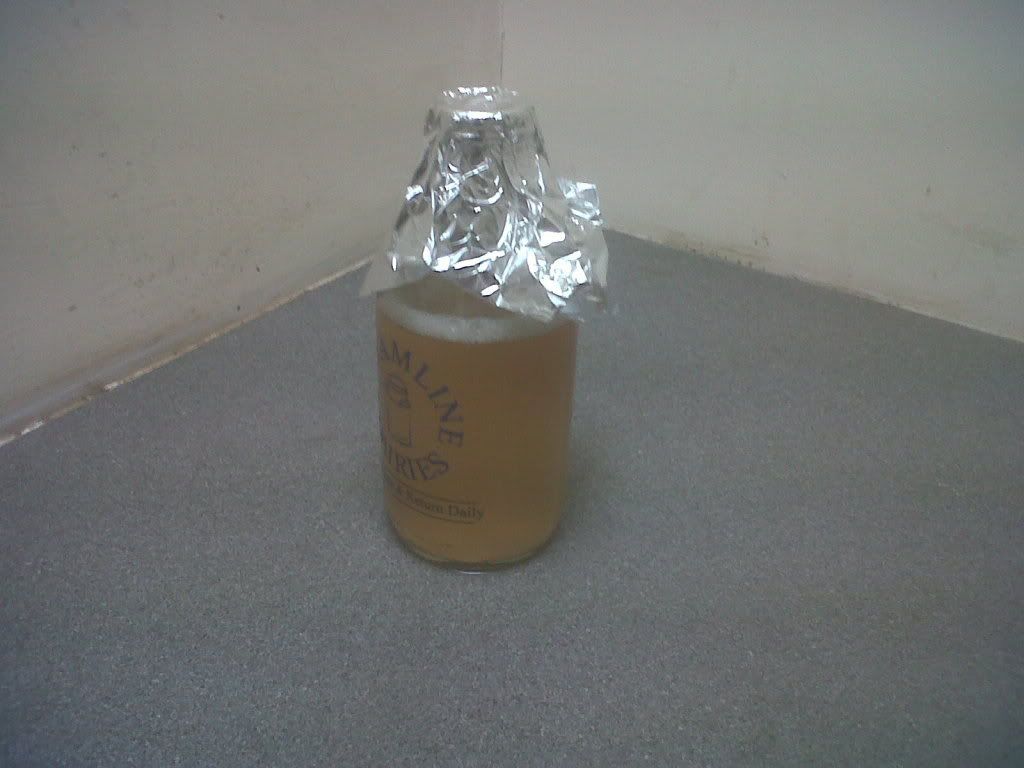graysalchemy
Active Member
- Joined
- Apr 15, 2010
- Messages
- 53
- Reaction score
- 19
Westons Old Rosie is an excellent cider and has the added advantage of being bottle conditioned. The yeast in these bottles is viable and makes an excellent yeast for a Turbo Cider or if you are lucky to have an apple tree a real cider. Old Rosie is readily available in Morrisons, Waitrose and Sainsbury's supermarkets and sometimes it is in Tesco's.
What you will need
1) 1 x 500ml bottle of Westons Old Rosie
2) 4 x 1L Apple Juice 100% from concentrate
3) 1 x tsp Yeast nutrient
4) Sterilising solution
5) 1 x 1pt milk bottle or 500ml conical flask
6) 1 x I gallon Demijohn with airlock.
7) A piece of Kitchen Foil
8) Plenty of patience

What to do
1)First of all you need to make sure that the yeast has settled in the bottom of the bottle. Because Old Rosie is a cloudy cider it may take a time to settle. Putting in the fridge for a few days is the best way.
2)Once it is settled and ready to use bring it out of the fridge and leave it to acclimatise to room temperature.
3)Once you cider has acclimatised open it and pour yourself a cider, being careful to leave the yeast and a glug of cider in the bottle

4) Sterilise you milk bottle or conical flask then pour the remainder of the bottles content into it.
5) Now you need to fill this up to within a couple of inches with apple juice and add 1 tsp of yeast nutrient. This is quite important as apple juice is actually low in some of the nutrients that yeast needs in order to grow.
6) Once you have done this you need to cover it with a piece of kitchen foil but remember to sterilise it first. It needs to be fairly loose so that oxygen can get in and carbon dioxide can get out.

7) Now give it a good shake to aerate it.
8) You now have to leave it somewhere warn, 18-21C
9) Give it a good swirl whenever you can, this aerates it and keeps the yeast in suspension .
10) After a few days you should begin to see a white film developing on the bottom.
11) The next stage is to let it settle and then pour off the liquid making sure you leave as much of the yeast behind as possible and a little of the liquid. Discard the rest of the liquid. You can save this and use to make cider vinegar.
12) Now you need to refill with fresh apple juice and repeat stages 5-10.
13) Once this has fermented out you can now grow it on in a demijohn with 3 L of apple Juice.
14) Again let it settle and drain off the liquid as per stage 11.
15) Sterilise your demijohn and airlock.
16) Pour the yeast slurry into the bottom and top up with 3L of apple juice and again 1 tsp of yeast nutrient.
17) Put in the air lock and give it a good shake to aerate again.
18) Leave it again at 18-21C giving it a good swirl periodically.
19) After a few days you should actually see a normal fermentation with plenty of airlock activity.
20) Let it ferment out usually 7-10 days then chill it to get the yeast out of suspension.
21) As before in stage 11 pour off the cider leaving the yeast slurry.
You now have a yeast starter which should be enough to do 30L of TC.
What you will need
1) 1 x 500ml bottle of Westons Old Rosie
2) 4 x 1L Apple Juice 100% from concentrate
3) 1 x tsp Yeast nutrient
4) Sterilising solution
5) 1 x 1pt milk bottle or 500ml conical flask
6) 1 x I gallon Demijohn with airlock.
7) A piece of Kitchen Foil
8) Plenty of patience

What to do
1)First of all you need to make sure that the yeast has settled in the bottom of the bottle. Because Old Rosie is a cloudy cider it may take a time to settle. Putting in the fridge for a few days is the best way.
2)Once it is settled and ready to use bring it out of the fridge and leave it to acclimatise to room temperature.
3)Once you cider has acclimatised open it and pour yourself a cider, being careful to leave the yeast and a glug of cider in the bottle

4) Sterilise you milk bottle or conical flask then pour the remainder of the bottles content into it.
5) Now you need to fill this up to within a couple of inches with apple juice and add 1 tsp of yeast nutrient. This is quite important as apple juice is actually low in some of the nutrients that yeast needs in order to grow.
6) Once you have done this you need to cover it with a piece of kitchen foil but remember to sterilise it first. It needs to be fairly loose so that oxygen can get in and carbon dioxide can get out.

7) Now give it a good shake to aerate it.
8) You now have to leave it somewhere warn, 18-21C
9) Give it a good swirl whenever you can, this aerates it and keeps the yeast in suspension .
10) After a few days you should begin to see a white film developing on the bottom.
11) The next stage is to let it settle and then pour off the liquid making sure you leave as much of the yeast behind as possible and a little of the liquid. Discard the rest of the liquid. You can save this and use to make cider vinegar.
12) Now you need to refill with fresh apple juice and repeat stages 5-10.
13) Once this has fermented out you can now grow it on in a demijohn with 3 L of apple Juice.
14) Again let it settle and drain off the liquid as per stage 11.
15) Sterilise your demijohn and airlock.
16) Pour the yeast slurry into the bottom and top up with 3L of apple juice and again 1 tsp of yeast nutrient.
17) Put in the air lock and give it a good shake to aerate again.
18) Leave it again at 18-21C giving it a good swirl periodically.
19) After a few days you should actually see a normal fermentation with plenty of airlock activity.
20) Let it ferment out usually 7-10 days then chill it to get the yeast out of suspension.
21) As before in stage 11 pour off the cider leaving the yeast slurry.
You now have a yeast starter which should be enough to do 30L of TC.



















![BREWING THERMOMETER STICKERS ACCURATELY MONITOR FERMENTING BEER & WINE LIQUID TEMPERATURES 5PCS HOME BREW SPIRITS WINE LCD ADHESIVE [US]](https://m.media-amazon.com/images/I/311DDjo2X3L._SL500_.jpg)






















 lactobacillus :rofl:
lactobacillus :rofl: